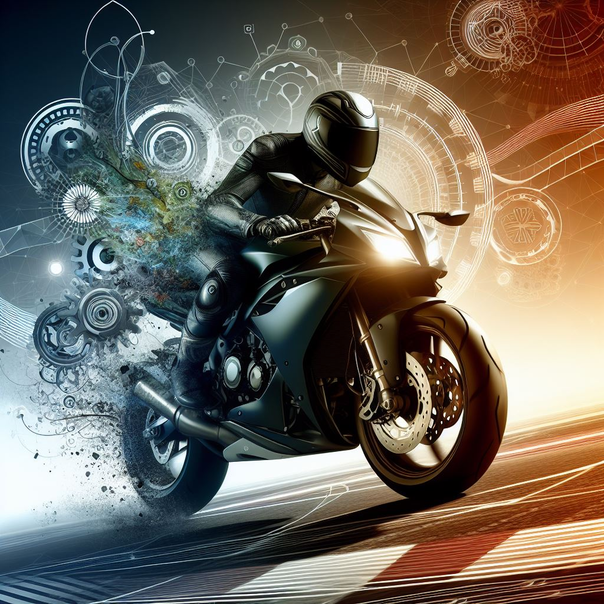
Learn effective motorcycle braking with our comprehensive guide. Discover the balance between front and rear brakes, and understand the differences between ABS and non-ABS systems. Enhance your riding safety and control with expert tips. #MotorcycleBraking #SafetyFirst #ABS #NonABS #RiderSkills #MotorcycleTips #SmoothBraking #BikerLife #MotorcycleSafety #RideWithConfidence
Braking effectively on a motorcycle requires more than just applying pressure to the levers. It demands a nuanced understanding of how the front and rear brakes work together, the balance needed between them, and the technological differences between ABS and non-ABS braking systems. This guide aims to equip riders with the knowledge to brake confidently and safely, ensuring smooth and controlled stops every time.
Understanding the Basics of Motorcycle Braking
Before delving into advanced techniques, it's essential to grasp the fundamental principles of motorcycle braking. Motorcycles are unique vehicles that require a delicate balance between the front and rear brakes. Unlike cars, where you can stomp on the brakes and rely on the ABS to do the work, motorcycles demand precision and coordination.
The front brake provides the majority of stopping power. Due to weight transfer during braking, most of the bike's weight shifts to the front wheel, making the front brake significantly more effective. On the other hand, the rear brake is crucial for stability and preventing the rear wheel from lifting off the ground. Knowing when and how to use each brake can make a significant difference in stopping distance and overall control.
The Symbiotic Relationship Between Front and Rear Brakes
Balancing the front and rear brakes is key to smooth and effective braking. Each brake serves a different purpose and should be used in conjunction to maximize performance. Here's a closer look at their roles:
· Front Brake: This is your primary stopping power. Applying the front brake transfers weight to the front wheel, increasing traction and stopping ability. However, using it too aggressively can cause the front wheel to lock up, leading to a skid.
· Rear Brake: While it provides less stopping power, the rear brake is essential for maintaining stability. It helps to keep the rear wheel grounded, preventing it from lifting and causing a potential loss of control.
The ideal braking technique involves using both brakes simultaneously but with varying pressure. Start with a gentle application of the rear brake, followed by a progressive squeeze of the front brake. This approach helps in distributing the braking force evenly, reducing the risk of skidding and ensuring a controlled stop.
The Art of Balanced Braking
Mastering the art of balanced braking involves practice and a keen sense of your motorcycle's behavior. Here are some tips to achieve the perfect balance:
1. Progressive Braking: Begin braking gently and increase pressure gradually. This allows the weight to transfer smoothly, enhancing traction and control.
2. Practice in Different Conditions: Braking behavior changes with road conditions. Practice in dry, wet, and uneven surfaces to understand how your motorcycle responds.
3. Feel the Feedback: Pay attention to the feedback from your bike. The handlebars and footpegs can give clues about traction and stability.
4. Stay Relaxed: Tension can lead to abrupt movements and poor control. Keep your body relaxed and let your bike do the work.
By following these tips, you can develop a natural feel for balanced braking, leading to smoother and safer rides.
ABS vs. Non-ABS Braking Systems
Understanding the difference between ABS and non-ABS braking systems is crucial for effective braking. Both systems have their advantages and learning how to use each can significantly enhance your riding experience.
· ABS (Anti-lock Braking System): ABS prevents wheel lock-up during hard braking by modulating brake pressure automatically. It allows you to brake hard while maintaining steering control, reducing the risk of skidding. ABS is particularly beneficial in wet or slippery conditions where wheel lock-up is more likely.
· Non-ABS: Braking on a non-ABS bike requires more skill and finesse. Riders must manually modulate brake pressure to prevent wheel lock-up. This system allows for more direct control and feedback, which some experienced riders prefer. However, it demands a higher level of skill to brake effectively, especially in adverse conditions.
Both systems have their place, and understanding their operation can help you choose the right braking technique for your motorcycle.
Practical Tips for Effective Braking
Effective braking isn't just about technique; it's also about preparation and mindset. Here are some practical tips to enhance your braking skills:
1. Maintain Your Brakes: Regularly check and maintain your brake system. Ensure pads, discs, and fluids are in good condition.
2. Use Engine Braking: Downshifting can help slow your bike without relying solely on the brakes, reducing wear and improving control.
3. Anticipate Stops: Look ahead and anticipate stops to avoid sudden braking. Smooth, gradual stops are safer and more comfortable.
4. Keep a Safe Distance: Always maintain a safe distance from the vehicle ahead, giving you ample time to brake smoothly.
5. Stay Alert: Focus on the road and be aware of your surroundings. Sudden stops are often the result of inattention.
By incorporating these tips into your riding habits, you can ensure more effective and safe braking.
Embracing Continuous Learning and Practice
Braking is a skill that improves with continuous learning and practice. Every ride offers an opportunity to refine your technique and build confidence. Consider taking advanced riding courses that focus on braking and other critical skills. These courses provide hands-on experience and professional guidance, accelerating your learning curve.
Moreover, staying updated with the latest braking technologies and techniques can keep you ahead of the curve. The motorcycle industry constantly evolves, and new innovations can enhance your braking performance.
Effective motorcycle braking is a blend of knowledge, practice, and technology. By understanding the roles of front and rear brakes, mastering balanced braking, and knowing the differences between ABS and non-ABS systems, you can brake smoothly and confidently. Always remember that practice makes perfect, and continuous learning is key to becoming a skilled rider.
Enjoy the ride, stay safe, and keep refining your braking skills. Happy riding!
